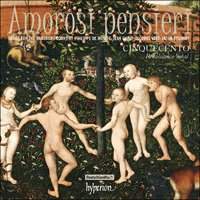Texte paru dans: / Appeared in:

Fanfare Magazine: 38:2 (11-12/2014)
Pour
s'abonner / Subscription information
Les abonnés à Fanfare Magazine ont accès aux archives du
magazine sur internet.
Subscribers to Fanfare Magazine have access to the archives of the magazine
on the net.
Hyperion
CDA68053

Code-barres / Barcode : 0034571280530 (ID419)
"Top marks, then. The performances are excellent, in a carefully designed and rewarding program."
The theme on the last release I reviewed of Cinquecento (Fanfare 36:3) was the death of Josquin, with deplorations set in his honor, and a Requiem by Richafort dedicated to his memory. On this disc we move forward in time to the chansons of a generation that was born slightly before or after his death. The term “songs” in the album title is to be taken loosely: No longer bound by the formes fixes of the 14th and 15th centuries, these could include monophonic and polyphonic pieces, elevated texts and suggestive ones, and music that emphasized vertical harmonies or counterpoint, or some combination of both.
The four composers featured here illustrate this range very well. The slower, more melancholy songs of Jean Guyot de Châtelet (c. 1512–1588) such as En lieux d’esbatz m’assault melancholie are entwined in a dense thicket of imitative vines, but the imitation is formed of shorter, swiftly rising and falling motifs in the more lighthearted, folk-like Je susi amoureux d’une fille—recalling to mind such popular chansons of Pierre Certon as Je ne fus jamais si aise.
Guyot wished to become the Kapellmeister to Holy Roman Emperor Ferdinand I, but the latter died months after Guyot’s arrival. His successor, Maximilian II, appointed Jacobus Vaet (c. 1529–1567) instead, and two of the latter’s three published chansons indicate his movement away from the highly imitative textures of the influential Gombert towards a basically homophonic setting with light polyphony—notably so in the pining Sans vous ne puis, with its repeated “n’aucune liesse” (no cheer). The year after Vaet died, Maximilian appointed the famous Philippe de Monte (1521–1603) to the post. His eight songs on this album cover the more elevated, tragic aspects of love, very much in the contemporary Italian manner of which he was a master. Jacob Regnart (c. 1540–1599) served under de Monte soon after the latter was appointed Kapellmeister but left after several years to study abroad, only returning to Prague in 1596 where he once more had de Monte as his Kapellmeister. His eight selections on this album include four in German and four in Italian, with a broad stylistic range: The three-voiced, almost strictly homophonic Venus du und dein Kind could be a solo French song with lute accompaniment under another guise, while the cleverly varied part-writing and Italianate thematic cast of Alarm’, alarm’, o fidi miei pensieri suggest familiarity with the latest developments in the Florentine madrigal.
In my previous review of Cinquecento, I commended the ensemble for “focus[ing] on individual lines, rather than striving for a homogenous sound,” and the greater transparency they brought to the music than a comparable recording of Paul van Nevel and his Huelgas Ensemble. Much the same can be said of this release, with a careful use of dynamics to emphasize everything from the top line (Amor, che debbo fare) to the baritone and bass parts (Alarm’, alarm). Their vocal range—two countertenors, two tenors, a baritone, and bass—in songs ranging from three parts to six provides a variety of textures, the high-lying delicacy of Regnart’s Ein Lieb nit mehr hat to de Monte’s richly sonorous Amorosi pensieri. Excellent enunciation and a dramatic attention to dynamics are welcome characteristics in music sometimes performed with all too great an expressive restraint.
Top marks, then. The performances are excellent, in a carefully designed and rewarding program.
Cliquez l'un ou l'autre
bouton pour découvrir bien d'autres critiques de CD
Click either button for many other reviews


